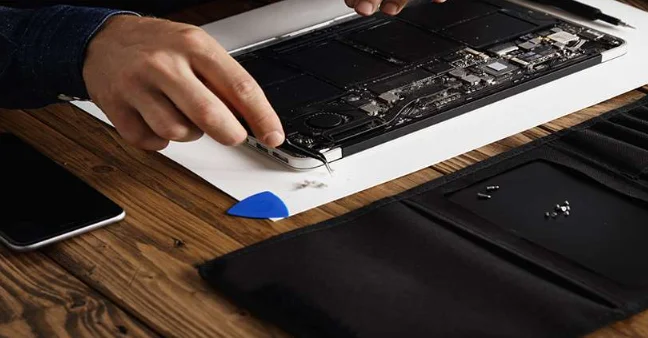MacBooks are known for their sleek design, reliability, and long battery life, but like any piece of technology, they can face issues over time. One of the most common problems users encounter is battery degradation. A MacBook’s battery is essential to its portability and functionality, so when it starts to falter, it raises an important question: should you repair or replace it?
In this article, we’ll explore common MacBook battery issues, when it makes sense to repair the battery, and when replacement is the better option.
Understanding MacBook Battery Life and Performance
Before diving into repair or replacement decisions, it’s important to understand how MacBook batteries work. MacBook batteries are lithium-ion based, designed to offer long life and efficiency. They are rated for a certain number of charge cycles (typically 1,000 full cycles), after which the battery’s ability to hold a charge starts to degrade.
A charge cycle occurs when you use 100% of the battery’s capacity, though it doesn’t have to happen all at once. For example, using 50% of the battery one day and 50% the next counts as one cycle. Over time, the battery’s maximum charge capacity will decrease, leading to shorter battery life.
Common MacBook Battery Issues
MacBook battery problems can manifest in several ways. If you’re experiencing any of the following issues, it’s time to assess whether to repair or replace the battery:
- Quick Battery Drain: One of the most common signs of a failing battery is rapid battery drain. If your MacBook once lasted all day on a single charge but now dies after just a few hours of light use, the battery may be degrading.
- Unexpected Shutdowns: Another sign of a faulty battery is when your MacBook shuts down unexpectedly, even though it shows battery life remaining. This indicates that the battery can no longer deliver consistent power to the system.
- Failure to Charge: If your MacBook won’t charge when plugged in, the issue could lie with the battery, charging port, or charger itself. Testing the charger and power outlet can help you narrow down the cause.
- Overheating: A degraded battery can cause your MacBook to overheat, which can damage other internal components. If you notice excessive heat while using or charging your MacBook, the battery may be failing.
- Swollen Battery: In rare cases, a MacBook battery can swell, causing the trackpad or keyboard to bulge. A swollen battery is a serious issue that requires immediate attention, as it poses a safety hazard.
When to Repair the Battery
In some cases, a battery repair or recalibration might resolve the issue, especially if the problem is software-related. Here’s when it makes sense to attempt repair:
- Battery Calibration Issues: If your battery percentage indicator seems inaccurate (for example, showing 30% battery left but suddenly shutting down), a battery calibration may help. This process involves fully draining and recharging the battery to help your MacBook better estimate the remaining charge.
- Software Updates: Sometimes, a software glitch or outdated macOS can cause your battery to drain faster than normal. Before opting for a replacement, make sure your MacBook’s software is up to date, and check for any background processes or apps that may be consuming power.
- Under Warranty: If your MacBook is still under warranty or covered by AppleCare, a repair or battery replacement from Apple may be covered at no extra cost. In this case, it’s worth reaching out to Apple Support to explore your repair options.
When to Replace the Battery
If the battery issues persist despite troubleshooting or if the battery has reached the end of its life cycle, replacement is often the best solution. Here are some scenarios where replacing the battery is the right choice:
- Cycle Count Exceeds 1,000: Once your battery’s cycle count exceeds 1,000, it’s considered “consumed” and may no longer hold a sufficient charge. At this point, replacement is recommended to restore your MacBook’s battery life.
- Battery Health Shows “Service Recommended”: If your battery status in the System Report shows “Service Recommended,” this is a clear indicator that the battery is deteriorating and needs to be replaced.
- Persistent Overheating: A battery that constantly overheats, even after updates and troubleshooting, is a sign of degradation. Replacing it will not only resolve the heat issue but also protect other components from damage due to excessive heat.
Should You Go to Apple or a Third-Party Repair Service?
When it’s time to replace the battery, you’ll have the option of going through Apple or opting for a third-party repair service. Here are the pros and cons of each:
- Apple Repair Services: If your MacBook is under warranty or AppleCare, taking it to an Apple Store or an authorized service provider is your best bet. Apple technicians use genuine parts and are trained to work specifically on MacBooks, ensuring the highest quality repair. However, if your warranty has expired, Apple’s repair costs can be relatively high.
- Third-Party Repair Services: If your MacBook is no longer under warranty, a third-party MacBooks repair service can offer more affordable options. Many third-party repair shops provide battery replacement services at a lower cost than Apple, but it’s important to ensure that they use high-quality replacement batteries and have experienced technicians.
Conclusion
MacBook battery issues are a common occurrence as the device ages, but understanding when to repair or replace the battery can save you time, money, and frustration. In many cases, replacing the battery is the best long-term solution, especially if the battery health is poor or the cycle count is high. Whether you choose to go through Apple or a third-party repair service, addressing the issue promptly will ensure your MacBook remains functional and reliable for years to come.
If you’re uncertain about the severity of your battery issue, consulting a professional can help you make the right decision for your device’s longevity and performance.

Shannon Reyes is a seasoned writer with a knack for crafting engaging blogs on a variety of service industries, including plumbing, cleansing, moving, pest control, and roofing. With a keen eye for detail and a passion for helping readers navigate complex topics, Shannon brings her expertise to life through informative and accessible content.










